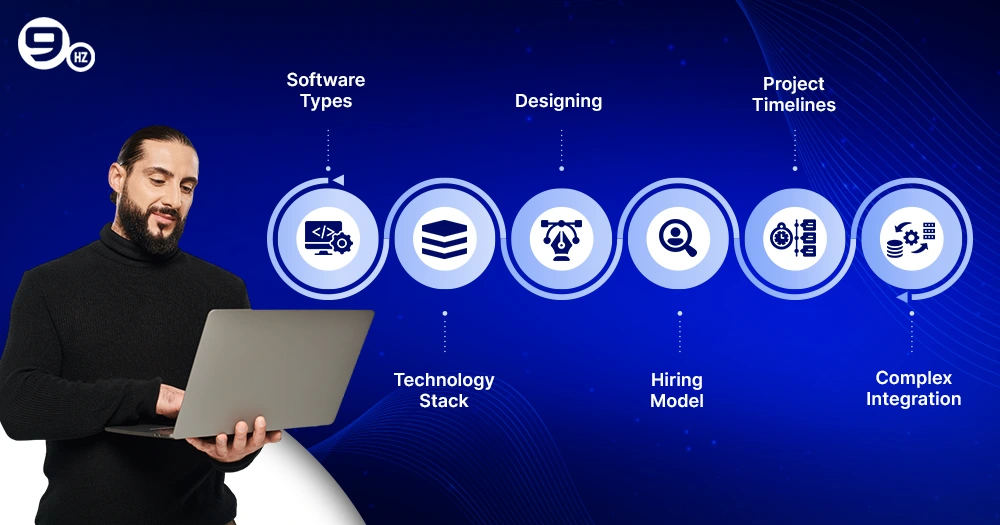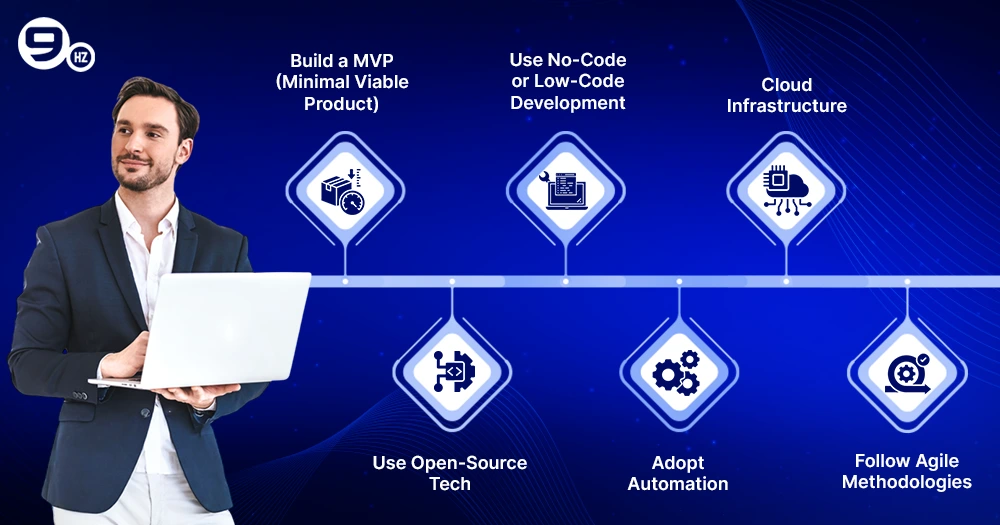Germany is one of the popular countries in Central Europe that offers a pool of developers, attracting fast-paced technologies and web development precision. Top cities like Frankfurt, Hamburg, Munich, and Berlin have been the centre of startups, tech hubs, and famous firms like Bosch, Siemens, and SAP. With growing demand, the German development market will rise at a CAGR of 10.8% from 2025 to 2030 to reach $78 million. It creates a positive indication of demand for software solutions in Germany after AI and ML transform the sector. Over 50% of German enterprises are using cloud infrastructure such as Azure, AWS, and or Open Cloud services.
From predictive analytics software to code generation tools, Germany has a scaling demand for software development. So, how much does it cost to build software in Germany? This comprehensive blog explores everything you need to know about software development Services in Germany, helping you understand the key factors that influence pricing based on project scope, technology, and complexity.
What is Software Development?
Software Development is the process of developing reliable software through designing the architecture, coding, manual or automated testing, and maintenance. The main aim is to develop the platform to meet the business objectives, goals, and processes. It begins with research on ideas, designing a data structure, writing technical documentation, APIs, debugging, launching on the right platform, and ongoing maintenance.
Software development cost in Germany mainly depends on the development process and the nature of the software. There are different types of software development:
- FrontEnd Development – It covers the aspect of frontend on how the website appears for users, including layout, UI/UX design, and other visual interactive elements.
- Backend Development – This revolves around building infrastructure to focus on core logic, system integration, functionalities that ensure for improving scalability and scalability.
- Full-Stack Development: Here, developers can build the frontend and backend with programming languages, feature integration, database, APIs, and deploy applications.
- DevOps Engineering: It includes a set of practices focusing on customer-centric software delivery following agile methodologies to build products with support for QA professionals.
Factors that Affect Software Development Cost in Germany
Software development has been a dynamic process where the overall cost to develop software is subject to change based on factors determining the final value of the product. Every company sets a unique set of features and functionalities based on its target industry, which directly affects the software development cost in Germany.
So, before you decide on how much does it cost to build software in Germany. Here is the list of considerable factors:
Software Types
One of the common factors is software types; if it has basic features and functionalities, this will cost less, while an advanced version will come at higher costs. Also, the cost will vary for application, system, or enterprise-level development.
Technology Stack
Based on software complexities in terms of tools, frameworks, and programming languages, there will be differences in software development cost in Germany. Open source tech like Python, PHP, and JavaScript costs less, while cloud providers like Google Cloud or Azure will be expensive.
Designing
UI/UX design has been the key element of software development considering icons, fonts, buttons, colors complexities. So, integrating custom animation components, personalised user interface, and responsive layout make navigation easier and will be costing more.
Hiring Model
The cost of hiring an in-house team for software development will be higher than freelancing or outsourcing to third-party providers. Companies with specific projects with a shorter deadline prefer freelancers for flexible payments, while in-house development works for complex projects.
Project Timelines
Timeframe has been a key factor affecting software development cost in Germany; shorter deadlines require more labour cost and resources. On the other side, projects with extended duration have evenly distributed costs while maintaining speed and efficiency.
Complex Integration
The cost to develop software also depends on features and tools integrations; it might be costlier to connect ERP software, payment gateways, and cross-platform compatibility. These integrations might require additional development efforts and testing requirements.
Average Hourly Rates in Germany
The company moves to hiring software developers on an hourly basis to keep their budget intact without compromising the quality of software. However, the cost of hiring software developers in Germany depends on their expertise, location, employment type, technology stack, and project requirements.
Here are the average hourly rates to hire developers in Germany:
- Junior Developers – €40 to €60 per hour
- Mid-level Developers – €60 to €90 per hour
- Senior Developers – €90 – €150 per hour
- Freelancers – €70 – €120 per hour
- Outsourcing – €50 to €100 per hour
Software Development Cost in Germany by Project Type
Software developers’ projects are categorised into different types depending on their nature and purposes. It can be web development projects based on HTML, CSS, or JavaScript, system software based on C and C++, application software, game software, and many more. Each category requires specific infrastructure, tech stack, or development stages that directly influence software development costs.
Let’s understand the breakdown of software development cost in Germany depending on multiple project types:
| Project Type | Estimated Hours | Hourly Rate (€) | Total Cost (€) |
|---|---|---|---|
| Basic Website / Landing Page | 50 – 100 hrs | €40 – €65 | €2,000 – €6,500 |
| Corporate Website (CMS) | 100 – 200 hrs | €45 – €70 | €4,500 – €14,000 |
| E-commerce Platform | 300 – 600 hrs | €50 – €75 | €15,000 – €45,000 |
| Mobile App (iOS/Android) | 500 – 900 hrs | €55 – €80 | €27,500 – €72,000 |
| Custom SaaS Product (MVP) | 600 – 1200 hrs | €60 – €90 | €36,000 – €108,000 |
| Enterprise Web Application | 1000 – 2000+ hrs | €70 – €100 | €70,000 – €200,000+ |
| AI/ML-Based Solution | 800 – 1500 hrs | €75 – €120 | €60,000 – €180,000 |
| Fintech / Blockchain App | 1000 – 1800 hrs | €80 – €130 | €80,000 – €234,000 |
| CRM / ERP Customization | 500 – 1000 hrs | €65 – €100 | €32,500 – €100,000 |
| API Integration + Backend Services | 200 – 500 hrs | €50 – €85 | €10,000 – €42,500 |
In-House Vs. Outsourced Development
As the name suggests, the core difference between these two development approaches how the development team operates. In-house software development means hiring a dedicated team of developers who work within the organization under the on-site model under direct management. Conversely, Outsourcing refers to hiring external developers or teams, mostly working in remote or offshore locations, to handle the development tasks.
For a clear understanding, let’s create a table representing core differences:
| Basis | In-House Development | Outsourced Development |
|---|---|---|
| Cost | Higher cost due to salaries, benefits, and equipment | Lower cost to hire for offshore/nearshore partners |
| Talent Access | Limited to local German developers | Access to international domain-specific talents |
| Control & Communication | It creates direct and real-time communication | For effective communication, it follows structured channels and documentation |
| Time to Hire | It takes a longer timeline to complete the entire process of recruitment and onboarding | Quick hiring through agencies and freelancing portals |
| Scalability | Compared to slower due to approval cycles and dependency on other departments | Easy to scale due to flexibility and freedom to implement changes |
| Quality Assurance | Internally, QA managed to create no risk for development | Depends on contracts and agreements for QA to still hold risk during development |
| Cultural Fit | Stronger (same company environment) | Varies; may require onboarding to the company culture |
| Infrastructure Costs | Higher cost due to investing in office space, tools, and software | Minimal investment as a vendor has its own infrastructure setups |
| Product Knowledge | Deep knowledge is gained over time and requires consistent training and support | Third-party hires are experts and require no training for product domain knowledge |
| Flexibility | Rigidity due to fixed schedules | High flexibility due to flexible pay modes and contract basis |
If we talk about the software development cost in Germany for these two approaches, it will be as follows:
In-House Development Cost
- Average Salary: €60,000–€90,000/year per developer
- Hourly Rate: €45–€65/hour
(Additional cost comprises Hiring & onboarding, Insurance, taxes, employee benefits, Office space & infrastructure, Software licenses, and equipment)
Outsource Development
- Local Outsourcing (Germany-based agencies): €50–€100/hour
- Nearshore (Eastern Europe): €25–€45/hour
- Offshore (India, LATAM, etc.): €15–€35/hour
Tips to Optimise Your Budget For Software Development
Software development with advanced features can be too expensive, so companies aim to look for ways to reduce development costs. They find it crucial to implement strategies to strike a financial balance between the cost of developing software and the quality standard. Here are the following tips to optimise for software development budget:
Build a MVP (Minimal Viable Product)
One of the effective tips is to build reliable software with minimal features, focusing only on core elements. It is easier to collect user information, build with open-source tools and frameworks, and deploy faster without spending too much on additional requirements.
Use Open-Source Tech
Using open-source tech is a useful step to cut down software costs without any compromise on quality factors. It saves licensing fees and expensive feature integration, offering more flexibility and scalability.
Use No-Code or Low-Code Development
Another cost-effective alternative would be using low-code or no-code alternatives that require no expertise and a basic drag-and-drop technique to create the infrastructure. It reduces too much dependency for the dev team and is ideal for startups and small businesses.
Adopt Automation
Automation helps to save more time and manual costs, avoiding wastage. Using automated code review tools like Codacy and SonarQube will help to maintain code quality, reduce time spent, and reduce costly configuration errors.
Cloud Infrastructure
Shifting towards cloud computing would be the best approach for cutting down costs, as it reduces the burden of installing physical servers, capital expenditure, and expense for unused capacity. This also reduces immediate costs and is available through pay-as-you-go models.
Follow Agile Methodologies
Another effective way to reduce development cost is through agile practices that implies continuous enhancements, flexibility and collaboration. This approach supports early user feedback decreasing post-release adjustments and minimise the cost based on estimated budget and project timelines.
Why Choose Ninehertz to Develop your Software?
Many businesses aim to invest in high-quality software solutions for minimising long-term maintenance risks and unexpected costs. That’s why it’s crucial to work with experienced professionals to deliver a custom-built product that fits user needs perfectly. With over 15+ years of experience in different sectors and more than 500+ developers, NineHertz provides domain-specific experts who address your business problem and develop the right software. We provide a dedicated team for research and development, fixed or flexible pricing models, and on-budget deliveries.
You will find all the latest AI models, APIs, LLM frameworks, and deployment tools to develop top digital solutions. From enterprise software, ERP, to supply chain management, you can consult with the team for any industry-based software development.
Conclusion
Finding a software development partner in Germany isn’t the challenge; instead, finding one that delivers high-quality solutions at a budget-friendly rate is. Software development cost in Germany might range between €37,000 and €280,000, depending on project requirements, tech stack, and pricing models. However, there are additional hidden costs involved, like technical debts and project delays that also should be considered. With proper planning and shortlisting vendors, businesses can find an ideal development partner to deploy the best-fit software within budget. However, cost reduction should not be there at the expense of compromising quality,
Frequently Asked Questions
What is the average cost of software development in Germany?
Overall, the average software development cost in Germany can fall between €30,000- €120,000, depending on team setup, tech stack, and project scope.
How long does it take to build a software product?
It takes around 3 to 6 months for basic software, while developing an advanced version or complex software might take 1 year.
Is it better to hire in-house or outsource?
Outsourcing is a viable option for short-term and MVP projects; on the other hand, in-house development works well for long-term projects.












